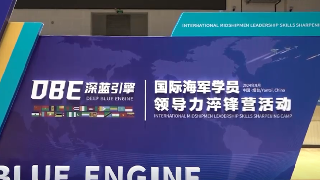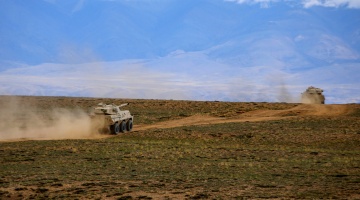By Sui Changquan and Xu Shiwei
隋長權(quán)、徐世偉
Recently, Japan Maritime Self-Defense Force conducted a Passing Exercise (PASSEX) with the Standing NATO Maritime Group 2 (SNMG2) and the Standing NATO Mine Countermeasures Group 2 (SNMCMG2) in the Eastern Mediterranean. The two sides dispatched five vessels for the exercise and conducted training on subjects including maneuvering exercises, communications drills, underwater explosive detection, and so on. Besides, sailors from both sides visited each other's ships in a cross-deck exercise.
近日,日本海上自衛(wèi)隊(duì)與北約常設(shè)海上第二大隊(duì)、海上第二掃雷大隊(duì),在東地中海附近海域舉行代號為“通行”的戰(zhàn)術(shù)演練。雙方共派出5艘艦艇參演,演練了水上機(jī)動(dòng)、通信聯(lián)絡(luò)、水下爆炸物探測等課目。另外,雙方艦員在跨甲板演練活動(dòng)中進(jìn)行了互訪交流。
According to a participating NATO official, the exercise has improved the interoperability and cooperation ability between NATO and Japan, enhanced the partnership between the two sides, and demonstrated the commitment of the alliance to ensuring the freedom of navigation and addressing regional security threats. Some foreign media commented that the exercise is of great significance in the context of the continuous tension in the security situations around the Mediterranean.
參演北約指揮官稱,此次演練提升了北約和日本的互操作性和合作能力,增進(jìn)了雙方伙伴關(guān)系,顯示出聯(lián)盟確保航行自由和應(yīng)對區(qū)域安全威脅的承諾。有外媒評論稱,在當(dāng)前地中海周邊安全局勢持續(xù)緊張的情況下,此次演練頗具深意。
Japan intends to reach three objectives through the exercise.
日本試圖通過此次演練達(dá)到“一石三鳥”的目的。
The first is to actively respond to the military cooperation with NATO. Since the beginning of this year, the security cooperation between Japan and NATO has been enhanced and tended to be institutionalized. Japanese Prime Minister Fumio Kishida has participated in NATO summits for three consecutive years. Meanwhile, NATO members have participated more frequently in joint training activities around Japan. In the first half of this year alone, at least 14 countries have conducted nearly 30 joint training activities with Japan in their surrounding areas. In contrast, Japan seldom participated in joint training activities in Europe. This exercise is considered an active response to the military cooperation with NATO by Japan.
一是積極回應(yīng)與北約的軍事合作。今年以來,日本與北約的安全合作持續(xù)升溫并不斷趨于機(jī)制化。日本首相岸田文雄連續(xù)第3年參加北約峰會(huì),北約成員國赴日本周邊參加聯(lián)合演訓(xùn)活動(dòng)更加頻繁,僅上半年,就有至少14個(gè)國家與日本在其周邊進(jìn)行了近30次聯(lián)合演訓(xùn)。相比而言,日本赴歐洲地區(qū)進(jìn)行聯(lián)合演訓(xùn)的次數(shù)較少,此次演練被視為日本對雙方軍事合作進(jìn)行的有力回應(yīng)。
The second is an ocean-going test for Starlink communication. Japan Training Squadron's JS Kashima in the exercise has been equipped with Starlink Internet satellite communication antenna in June this year. Japan has designed a 175-day overseas patrol training mission covering 11 countries to test the communication performance of Starlink and achieve full coverage of the ground, air, and maritime Self-Defense Force as soon as possible. This joint exercise in the Eastern Mediterranean is a part of the mission.
二是對“星鏈”通信進(jìn)行遠(yuǎn)洋測試。參加此次演練的日本“鹿島”號訓(xùn)練艦,于今年6月配備“星鏈”互聯(lián)網(wǎng)衛(wèi)星通信天線。為測試“星鏈”通信性能,以便盡快讓“星鏈”通信全面覆蓋陸海空自衛(wèi)隊(duì),日本設(shè)計(jì)了為期175天覆蓋11個(gè)國家的海外巡訪訓(xùn)練任務(wù)。此次在東地中海進(jìn)行聯(lián)合軍演,是上述訓(xùn)練任務(wù)中的一項(xiàng)計(jì)劃。
The third is to accelerate the military integration with NATO. Encouraged by the US, the military integration between the US and Japan has been gradually expanding from the two countries to Japan and the allies of the US. This joint exercise involved maneuvering exercises, communications drills, and underwater explosive detection, and so on. It aims to improve the interoperability of the two sides and deepen the military integration between Japan and the US as well as its allies.
三是加速推動(dòng)與北約軍事一體化。在美國鼓動(dòng)下,日美軍事一體化的范圍逐漸擴(kuò)大,由單純的日美兩國擴(kuò)展到日本與美國及其盟友間的一體化。此次演習(xí)涉及水上機(jī)動(dòng)、通信聯(lián)絡(luò)、水下爆炸物探測等內(nèi)容,旨在通過演練加強(qiáng)雙方互操作性,推動(dòng)日本與美國及其盟友的軍事一體化走深走實(shí)。
Judging from the time, location, and participating forces of the joint exercise, NATO also has its own calculations.
從參演時(shí)間、地點(diǎn)和參演力量等方面看,北約參加此次演習(xí)也有自己的小算盤。
At present, the Russia-Ukraine conflict has reached a stalemate. NATO is deeply trapped in it, so it is urgent to get external forces in to ease its strategic pressure. For the location, the Eastern Mediterranean connects Europe, Africa and Asia, and is an important channel for NATO to transport strategic materials to Ukraine. In terms of the participating forces, the multinational comprehensive maritime force dispatched by NATO is equipped with advanced mine hunters and minesweepers, which can not only provide military support at sea, but also detect, identify and eliminate mines and explosive ordnance.
演練時(shí)間上,當(dāng)前俄烏沖突進(jìn)入拉鋸消耗期,北約深陷其中難以自拔,急需有外部力量加入,緩解其戰(zhàn)略壓力;演練地點(diǎn)上,東地中海連接歐洲、非洲、亞洲,是北約向?yàn)蹩颂m運(yùn)輸戰(zhàn)略物資的重要通道;參演力量上,北約派出的多國綜合海上部隊(duì),裝備先進(jìn)的獵雷艦和掃雷艦,不僅可進(jìn)行海上軍事支援,還能探測、識別和排除水雷和爆炸性彈藥。
In conclusion, NATO has two purposes. On the one hand, it attempts to draw Japan into the Russia-Ukraine conflict and relieve the strategic pressure brought by European aid to Ukraine with the help of Japanese funds, resources and military forces; on the other hand, the exercise of combat support forces of NATO in the Eastern Mediterranean can demonstrate its ability to protect important sea route while showing strategic deterrence against Russia.
綜合來看,北約借此演練,一方面企圖將日本深度拉入俄烏沖突,借助日本的資金、資源和軍事力量,緩解歐洲援烏帶來的戰(zhàn)略壓力;另一方面,北約在東地中海使用作戰(zhàn)支援力量實(shí)施演練,意圖展現(xiàn)其保護(hù)海上重要通道的能力,同時(shí)對俄羅斯進(jìn)行戰(zhàn)略威懾。









